+ データを開く
データを開く
- 基本情報
基本情報
| 登録情報 | データベース: EMDB / ID: EMD-31423 | |||||||||
|---|---|---|---|---|---|---|---|---|---|---|
| タイトル | Cryo-EM structure of the chemokine receptor CCR5 in complex with RANTES and Gi | |||||||||
 マップデータ マップデータ | ||||||||||
 試料 試料 |
| |||||||||
 キーワード キーワード | G protein-coupled receptor / Chemokine receptor CCR5 / RANTES / SIGNALING PROTEIN | |||||||||
| 機能・相同性 |  機能・相同性情報 機能・相同性情報regulation of chronic inflammatory response / CCR4 chemokine receptor binding / activation of phospholipase D activity / chemokine receptor antagonist activity / chemokine (C-C motif) ligand 5 binding / : / CCR1 chemokine receptor binding / positive regulation of natural killer cell chemotaxis / negative regulation of macrophage apoptotic process / chemokine receptor binding ...regulation of chronic inflammatory response / CCR4 chemokine receptor binding / activation of phospholipase D activity / chemokine receptor antagonist activity / chemokine (C-C motif) ligand 5 binding / : / CCR1 chemokine receptor binding / positive regulation of natural killer cell chemotaxis / negative regulation of macrophage apoptotic process / chemokine receptor binding / signaling / cell surface receptor signaling pathway via STAT / chemokine receptor activity / positive regulation of cell-cell adhesion mediated by integrin / receptor signaling protein tyrosine kinase activator activity / CCR5 chemokine receptor binding / positive regulation of T cell chemotaxis / positive regulation of homotypic cell-cell adhesion / CCR chemokine receptor binding / C-C chemokine receptor activity / neutrophil activation / positive regulation of G protein-coupled receptor signaling pathway / positive regulation of T cell apoptotic process / C-C chemokine binding / phosphatidylinositol phospholipase C activity / negative regulation of T cell apoptotic process / regulation of T cell activation / positive regulation of calcium ion transport / eosinophil chemotaxis / response to cholesterol / positive regulation of innate immune response / positive regulation of monocyte chemotaxis / cellular response to fibroblast growth factor stimulus / chemokine-mediated signaling pathway / Chemokine receptors bind chemokines / chemokine activity / dendritic cell chemotaxis / release of sequestered calcium ion into cytosol by sarcoplasmic reticulum / negative regulation of G protein-coupled receptor signaling pathway / negative regulation of viral genome replication / leukocyte cell-cell adhesion / phospholipase activator activity / positive regulation of macrophage chemotaxis / macrophage chemotaxis / positive regulation of smooth muscle cell migration / chemoattractant activity / monocyte chemotaxis / Interleukin-10 signaling / exocytosis / cellular response to interleukin-1 / negative regulation by host of viral transcription / T cell migration / positive regulation of T cell migration / D2 dopamine receptor binding / Binding and entry of HIV virion / Adenylate cyclase inhibitory pathway / positive regulation of protein localization to cell cortex / positive regulation of translational initiation / cellular defense response / positive regulation of viral genome replication / regulation of cAMP-mediated signaling / coreceptor activity / G protein-coupled serotonin receptor binding / positive regulation of T cell proliferation / positive regulation of phosphorylation / cellular response to forskolin / positive regulation of tyrosine phosphorylation of STAT protein / regulation of mitotic spindle organization / regulation of insulin secretion / adenylate cyclase-inhibiting G protein-coupled receptor signaling pathway / positive regulation of cell adhesion / positive regulation of epithelial cell proliferation / cell chemotaxis / epithelial cell proliferation / Regulation of insulin secretion / G protein-coupled receptor binding / positive regulation of smooth muscle cell proliferation / calcium-mediated signaling / response to virus / G-protein beta/gamma-subunit complex binding / Olfactory Signaling Pathway / adenylate cyclase-modulating G protein-coupled receptor signaling pathway / Activation of the phototransduction cascade / G beta:gamma signalling through PLC beta / Presynaptic function of Kainate receptors / Thromboxane signalling through TP receptor / G protein-coupled acetylcholine receptor signaling pathway / cellular response to virus / cellular response to type II interferon / G-protein activation / Activation of G protein gated Potassium channels / Inhibition of voltage gated Ca2+ channels via Gbeta/gamma subunits / Prostacyclin signalling through prostacyclin receptor / response to peptide hormone / Glucagon signaling in metabolic regulation / G beta:gamma signalling through CDC42 / response to toxic substance / G beta:gamma signalling through BTK / ADP signalling through P2Y purinoceptor 12 / Sensory perception of sweet, bitter, and umami (glutamate) taste 類似検索 - 分子機能 | |||||||||
| 生物種 |  Homo sapiens (ヒト) Homo sapiens (ヒト) | |||||||||
| 手法 | 単粒子再構成法 / クライオ電子顕微鏡法 / 解像度: 3.0 Å | |||||||||
 データ登録者 データ登録者 | Zhang H / Chen K | |||||||||
| 資金援助 |  中国, 2件 中国, 2件
| |||||||||
 引用 引用 |  ジャーナル: Nat Commun / 年: 2021 ジャーナル: Nat Commun / 年: 2021タイトル: Structural basis for chemokine recognition and receptor activation of chemokine receptor CCR5. 著者: Hui Zhang / Kun Chen / Qiuxiang Tan / Qiang Shao / Shuo Han / Chenhui Zhang / Cuiying Yi / Xiaojing Chu / Ya Zhu / Yechun Xu / Qiang Zhao / Beili Wu /  要旨: The chemokine receptor CCR5 plays a vital role in immune surveillance and inflammation. However, molecular details that govern its endogenous chemokine recognition and receptor activation remain ...The chemokine receptor CCR5 plays a vital role in immune surveillance and inflammation. However, molecular details that govern its endogenous chemokine recognition and receptor activation remain elusive. Here we report three cryo-electron microscopy structures of G protein-coupled CCR5 in a ligand-free state and in complex with the chemokine MIP-1α or RANTES, as well as the crystal structure of MIP-1α-bound CCR5. These structures reveal distinct binding modes of the two chemokines and a specific accommodate pattern of the chemokine for the distal N terminus of CCR5. Together with functional data, the structures demonstrate that chemokine-induced rearrangement of toggle switch and plasticity of the receptor extracellular region are critical for receptor activation, while a conserved tryptophan residue in helix II acts as a trigger of receptor constitutive activation. | |||||||||
| 履歴 |
|
- 構造の表示
構造の表示
| ムービー |
 ムービービューア ムービービューア |
|---|---|
| 構造ビューア | EMマップ:  SurfView SurfView Molmil Molmil Jmol/JSmol Jmol/JSmol |
| 添付画像 |
- ダウンロードとリンク
ダウンロードとリンク
-EMDBアーカイブ
| マップデータ |  emd_31423.map.gz emd_31423.map.gz | 59.8 MB |  EMDBマップデータ形式 EMDBマップデータ形式 | |
|---|---|---|---|---|
| ヘッダ (付随情報) |  emd-31423-v30.xml emd-31423-v30.xml emd-31423.xml emd-31423.xml | 13.7 KB 13.7 KB | 表示 表示 |  EMDBヘッダ EMDBヘッダ |
| 画像 |  emd_31423.png emd_31423.png | 32.1 KB | ||
| Filedesc metadata |  emd-31423.cif.gz emd-31423.cif.gz | 5.9 KB | ||
| アーカイブディレクトリ |  http://ftp.pdbj.org/pub/emdb/structures/EMD-31423 http://ftp.pdbj.org/pub/emdb/structures/EMD-31423 ftp://ftp.pdbj.org/pub/emdb/structures/EMD-31423 ftp://ftp.pdbj.org/pub/emdb/structures/EMD-31423 | HTTPS FTP |
-検証レポート
| 文書・要旨 |  emd_31423_validation.pdf.gz emd_31423_validation.pdf.gz | 513.6 KB | 表示 |  EMDB検証レポート EMDB検証レポート |
|---|---|---|---|---|
| 文書・詳細版 |  emd_31423_full_validation.pdf.gz emd_31423_full_validation.pdf.gz | 513.2 KB | 表示 | |
| XML形式データ |  emd_31423_validation.xml.gz emd_31423_validation.xml.gz | 6 KB | 表示 | |
| CIF形式データ |  emd_31423_validation.cif.gz emd_31423_validation.cif.gz | 6.9 KB | 表示 | |
| アーカイブディレクトリ |  https://ftp.pdbj.org/pub/emdb/validation_reports/EMD-31423 https://ftp.pdbj.org/pub/emdb/validation_reports/EMD-31423 ftp://ftp.pdbj.org/pub/emdb/validation_reports/EMD-31423 ftp://ftp.pdbj.org/pub/emdb/validation_reports/EMD-31423 | HTTPS FTP |
-関連構造データ
- リンク
リンク
| EMDBのページ |  EMDB (EBI/PDBe) / EMDB (EBI/PDBe) /  EMDataResource EMDataResource |
|---|---|
| 「今月の分子」の関連する項目 |
- マップ
マップ
| ファイル |  ダウンロード / ファイル: emd_31423.map.gz / 形式: CCP4 / 大きさ: 64 MB / タイプ: IMAGE STORED AS FLOATING POINT NUMBER (4 BYTES) ダウンロード / ファイル: emd_31423.map.gz / 形式: CCP4 / 大きさ: 64 MB / タイプ: IMAGE STORED AS FLOATING POINT NUMBER (4 BYTES) | ||||||||||||||||||||||||||||||||||||||||||||||||||||||||||||||||||||
|---|---|---|---|---|---|---|---|---|---|---|---|---|---|---|---|---|---|---|---|---|---|---|---|---|---|---|---|---|---|---|---|---|---|---|---|---|---|---|---|---|---|---|---|---|---|---|---|---|---|---|---|---|---|---|---|---|---|---|---|---|---|---|---|---|---|---|---|---|---|
| 投影像・断面図 | 画像のコントロール
画像は Spider により作成 | ||||||||||||||||||||||||||||||||||||||||||||||||||||||||||||||||||||
| ボクセルのサイズ | X=Y=Z: 1.045 Å | ||||||||||||||||||||||||||||||||||||||||||||||||||||||||||||||||||||
| 密度 |
| ||||||||||||||||||||||||||||||||||||||||||||||||||||||||||||||||||||
| 対称性 | 空間群: 1 | ||||||||||||||||||||||||||||||||||||||||||||||||||||||||||||||||||||
| 詳細 | EMDB XML:
CCP4マップ ヘッダ情報:
| ||||||||||||||||||||||||||||||||||||||||||||||||||||||||||||||||||||
-添付データ
- 試料の構成要素
試料の構成要素
-全体 : Chemokine receptor CCR5 in complex with RANTES and Gi
| 全体 | 名称: Chemokine receptor CCR5 in complex with RANTES and Gi |
|---|---|
| 要素 |
|
-超分子 #1: Chemokine receptor CCR5 in complex with RANTES and Gi
| 超分子 | 名称: Chemokine receptor CCR5 in complex with RANTES and Gi タイプ: complex / ID: 1 / 親要素: 0 / 含まれる分子: all |
|---|---|
| 由来(天然) | 生物種:  Homo sapiens (ヒト) Homo sapiens (ヒト) |
-分子 #1: C-C motif chemokine 5,C-C chemokine receptor type 5
| 分子 | 名称: C-C motif chemokine 5,C-C chemokine receptor type 5 / タイプ: protein_or_peptide / ID: 1 / 詳細: Fusion protein of RANTES and CCR5 / コピー数: 1 / 光学異性体: LEVO |
|---|---|
| 由来(天然) | 生物種:  Homo sapiens (ヒト) Homo sapiens (ヒト) |
| 分子量 | 理論値: 52.101227 KDa |
| 組換発現 | 生物種:  |
| 配列 | 文字列: SPYSSDTTPC CFAYIARPLP RAHIKEYCYT SGKCSNPAVV FVTRKNRQVC ANPEKKWVRE YINSLEMSEF LEGSGSGSGS GSGSGSGSG SGSGSGSDYQ VSSPIYDINY YTSEPCQKIN VKQIAARLLP PLYSLVFIFG FVGNMLVILI LINCKRLKSM T DIYLLNLA ...文字列: SPYSSDTTPC CFAYIARPLP RAHIKEYCYT SGKCSNPAVV FVTRKNRQVC ANPEKKWVRE YINSLEMSEF LEGSGSGSGS GSGSGSGSG SGSGSGSDYQ VSSPIYDINY YTSEPCQKIN VKQIAARLLP PLYSLVFIFG FVGNMLVILI LINCKRLKSM T DIYLLNLA ISDLFFLLTV PFWAHYAAAQ WDFGNTMCQL LTGLYFIGFF SGIFFIILLT IDRYLAVVHA VFALKARTVT FG VVTSVIT WVVAVFASLP NIIFTRSQKC GLHYTCSSHF PYSQYQFWKN FQTLKIVILG LVLPLLVMVI CYSGILKTLL RCR NEKKRH RAVRLIFTIM IVYFLFWAPY NIVLLLNTFQ EFFGLNNCSS SNRLDQAMQV TETLGMTHCC INPIIYAFVG EKFR NYLLV FFQKHIAKRE FLEVLFQGPG SWSHPQFEKG SGAGASAGSW SHPQFEKGSD YKDDDDK UniProtKB: C-C motif chemokine 5, C-C chemokine receptor type 5 |
-分子 #2: Guanine nucleotide-binding protein G(i) subunit alpha-1
| 分子 | 名称: Guanine nucleotide-binding protein G(i) subunit alpha-1 タイプ: protein_or_peptide / ID: 2 / コピー数: 1 / 光学異性体: LEVO |
|---|---|
| 由来(天然) | 生物種:  Homo sapiens (ヒト) Homo sapiens (ヒト) |
| 分子量 | 理論値: 40.447141 KDa |
| 組換発現 | 生物種:  |
| 配列 | 文字列: MGCTLSAEDK AAVERSKMID RNLREDGEKA AREVKLLLLG AGESGKCTIV KQMKIIHEAG YSEEECKQYK AVVYSNTIQS IIAIIRAMG RLKIDFGDSA RADDARQLFV LAGAAEEGFM TAELAGVIKR LWKDSGVQAC FNRSREYQLN DSAAYYLNDL D RIAQPNYI ...文字列: MGCTLSAEDK AAVERSKMID RNLREDGEKA AREVKLLLLG AGESGKCTIV KQMKIIHEAG YSEEECKQYK AVVYSNTIQS IIAIIRAMG RLKIDFGDSA RADDARQLFV LAGAAEEGFM TAELAGVIKR LWKDSGVQAC FNRSREYQLN DSAAYYLNDL D RIAQPNYI PTQQDVLRTR VKTTGIVETH FTFKDLHFKM FDVTAQRSER KKWIHCFEGV TAIIFCVALS DYDLVLAEDE EM NRMHASM KLFDSICNNK WFTDTSIILF LNKKDLFEEK IKKSPLTICY PEYAGSNTYE EAAAYIQCQF EDLNKRKDTK EIY THFTCS TDTKNVQFVF DAVTDVIIKN NLKDCGLF UniProtKB: Guanine nucleotide-binding protein G(i) subunit alpha-1 |
-分子 #3: Guanine nucleotide-binding protein G(I)/G(S)/G(T) subunit beta-1
| 分子 | 名称: Guanine nucleotide-binding protein G(I)/G(S)/G(T) subunit beta-1 タイプ: protein_or_peptide / ID: 3 / コピー数: 1 / 光学異性体: LEVO |
|---|---|
| 由来(天然) | 生物種:  Homo sapiens (ヒト) Homo sapiens (ヒト) |
| 分子量 | 理論値: 37.41693 KDa |
| 組換発現 | 生物種:  |
| 配列 | 文字列: MSELDQLRQE AEQLKNQIRD ARKACADATL SQITNNIDPV GRIQMRTRRT LRGHLAKIYA MHWGTDSRLL VSASQDGKLI IWDSYTTNK VHAIPLRSSW VMTCAYAPSG NYVACGGLDN ICSIYNLKTR EGNVRVSREL AGHTGYLSCC RFLDDNQIVT S SGDTTCAL ...文字列: MSELDQLRQE AEQLKNQIRD ARKACADATL SQITNNIDPV GRIQMRTRRT LRGHLAKIYA MHWGTDSRLL VSASQDGKLI IWDSYTTNK VHAIPLRSSW VMTCAYAPSG NYVACGGLDN ICSIYNLKTR EGNVRVSREL AGHTGYLSCC RFLDDNQIVT S SGDTTCAL WDIETGQQTT TFTGHTGDVM SLSLAPDTRL FVSGACDASA KLWDVREGMC RQTFTGHESD INAICFFPNG NA FATGSDD ATCRLFDLRA DQELMTYSHD NIICGITSVS FSKSGRLLLA GYDDFNCNVW DALKADRAGV LAGHDNRVSC LGV TDDGMA VATGSWDSFL KIWN UniProtKB: Guanine nucleotide-binding protein G(I)/G(S)/G(T) subunit beta-1 |
-分子 #4: Guanine nucleotide-binding protein G(I)/G(S)/G(O) subunit gamma-2
| 分子 | 名称: Guanine nucleotide-binding protein G(I)/G(S)/G(O) subunit gamma-2 タイプ: protein_or_peptide / ID: 4 / コピー数: 1 / 光学異性体: LEVO |
|---|---|
| 由来(天然) | 生物種:  Homo sapiens (ヒト) Homo sapiens (ヒト) |
| 分子量 | 理論値: 7.861143 KDa |
| 組換発現 | 生物種:  |
| 配列 | 文字列: MASNNTASIA QARKLVEQLK MEANIDRIKV SKAAADLMAY CEAHAKEDPL LTPVPASENP FREKKFFCAI L UniProtKB: Guanine nucleotide-binding protein G(I)/G(S)/G(O) subunit gamma-2 |
-実験情報
-構造解析
| 手法 | クライオ電子顕微鏡法 |
|---|---|
 解析 解析 | 単粒子再構成法 |
| 試料の集合状態 | particle |
- 試料調製
試料調製
| 緩衝液 | pH: 7.5 |
|---|---|
| 凍結 | 凍結剤: ETHANE |
- 電子顕微鏡法
電子顕微鏡法
| 顕微鏡 | FEI TITAN KRIOS |
|---|---|
| 撮影 | フィルム・検出器のモデル: GATAN K3 BIOQUANTUM (6k x 4k) 平均電子線量: 2.1875 e/Å2 |
| 電子線 | 加速電圧: 300 kV / 電子線源:  FIELD EMISSION GUN FIELD EMISSION GUN |
| 電子光学系 | 照射モード: SPOT SCAN / 撮影モード: BRIGHT FIELD |
| 実験機器 |  モデル: Titan Krios / 画像提供: FEI Company |
- 画像解析
画像解析
| 初期モデル | モデルのタイプ: INSILICO MODEL |
|---|---|
| 最終 再構成 | 解像度のタイプ: BY AUTHOR / 解像度: 3.0 Å / 解像度の算出法: FSC 0.143 CUT-OFF / 使用した粒子像数: 1304062 |
| 初期 角度割当 | タイプ: MAXIMUM LIKELIHOOD |
| 最終 角度割当 | タイプ: MAXIMUM LIKELIHOOD |
 ムービー
ムービー コントローラー
コントローラー









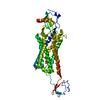
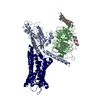
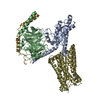

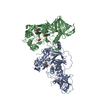
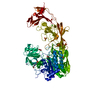
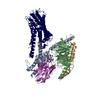

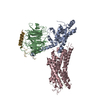
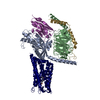



































 Z (Sec.)
Z (Sec.) Y (Row.)
Y (Row.) X (Col.)
X (Col.)





















